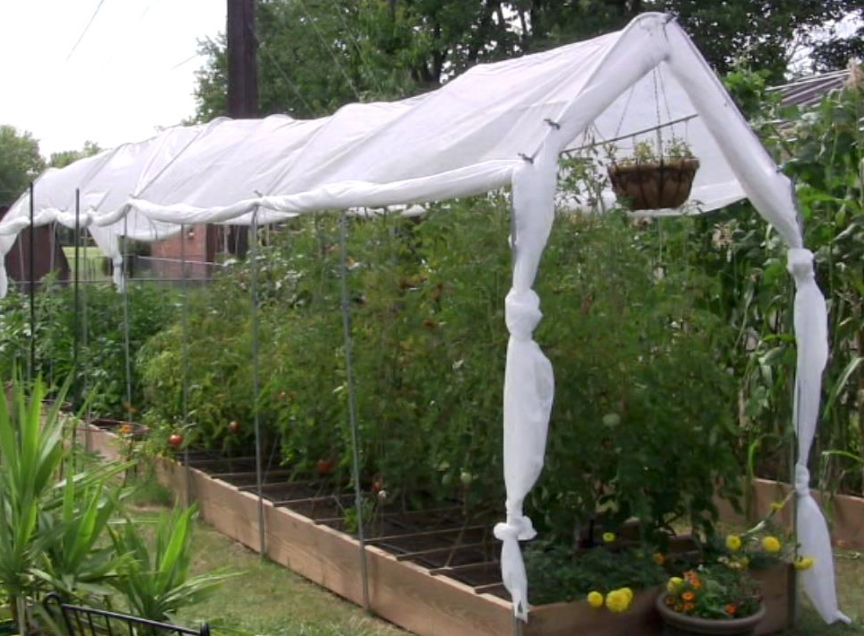 May 18, 2019 - By Bob Labozetta (UC Master Gardener, Mariposa) - This final part of the series on growing tomatoes in our hot, dry climate details proper cultivation techniques.
May 18, 2019 - By Bob Labozetta (UC Master Gardener, Mariposa) - This final part of the series on growing tomatoes in our hot, dry climate details proper cultivation techniques.
In areas with no natural shade, use shade cloth to cool tomatoes during the hours of most intense sunlight (usually between 10:00 A.M. and 4:00 P.M.) Orient the shade structure (example shown below) so it is open to the east (no cloth on that side.) Build a simple frame around the plants using wood or row cover hoops, then drape shade cloth over it.
Cage tomatoes rather than staking them. Caging allows unpruned foliage to protect the fruit from sunscald. Any pruning should be limited to no fewer than 3 to 4 main stems.
As soon as plants are established in the garden, place cages around them. Metal fencing or concrete reinforcing wire (“remesh”) are ideal materials for caging. Cages should be 3 to 6 feet tall and 18 to 30 inches in diameter. Use shorter cages for determinant varieties and taller ones for indeterminate types. The openings in the materials should be at least 6 inches square to allow for easy pruning and picking of fruit.
 Tomato shade cloth
Tomato shade cloth
Be sure to add mulch! A consistent 3-to 4-inch thick mulch layer around tomato plants will help keep soil moist, keep weeds at bay, keep plants clean, and add organic matter to the soil as it breaks down. Replenish mulch as it decomposes (usually late summer.) Organic materials like straw, cotton hulls, shredded bark, chopped leaves, untreated grass clippings, weed-free straw, or other locally available materials make great choices.
When temperatures reach 90℉ and above, tomato plants need ample water. Using your finger, feel an inch or so into the soil each morning to determine dampness. If the soil is dry, it’s time to water. Moist, not soaking wet, soil helps prevent fruit cracking and also reduces blossom drop. For sandy, fast-draining soils, you may need to water plants daily or even twice a day during the hottest days of summer. Water early in the day two or three times per week or as needed to keep the soil moist 1 inch beneath the surface.
Consider using drip irrigation or soaker hoses, which are more efficient than overhead sprinklers and help prevent the spread of fungal disease.
If a period of intense heat is forecasted, pick any fruit already showing hints of ripe color and allow them to finish ripening indoors.
The U.C. Master Gardener Helpline is staffed; Thursdays from 2:00 p.m. - 5:00 p.m.
Serving Mariposa County, including Greeley Hill, Coulterville and Lake Don Pedro
Please contact the helpline, or leave a message by phone at: (209) 966-7078
By email (send photos and questions for researched answers) to: mgmariposa@ucdavis.edu
For further gardening information and event announcements, please visit:
UCMG website: cemariposa.ucanr.edu/Master_Gardener
Follow us on Facebook at: Facebook.com/mariposamastergardeners
Master Gardener Office Location:
UC Cooperative Extension Office,
5009 Fairgrounds Road
Mariposa, CA 95338
Phone: (209) 966-2417
Email: mgmariposa@ucdavis.edu
Website: cemariposa.ucanr.edu/Master_Gardener








